When it comes to lifting belts, the debate between leather and nylon is a topic that every lifter faces. While both types have their advantages and disadvantages, understanding their differences can help you make an informed decision based on your specific needs. In this guide, we'll break down the pros and cons of leather and nylon lifting belts, explore their suitability for various workouts, and highlight key considerations before making a purchase.
Choosing the Right Lifting Belt
Choosing the right lifting belt can significantly impact your performance and safety. A lifting belt provides support for your lower back and abdominal area, reducing the risk of injury while lifting heavy weights.
When selecting a lifting belt, it's essential to consider your training style, the type of lifts you perform, and your comfort preferences.
Both leather and nylon belts have their benefits, but one may be more suitable for your specific needs. Let's explore the differences between the two materials to help you decide which one works best for you.
What is a Nylon Belt?

A nylon belt is made from synthetic fabric known for its flexibility and lightweight nature. These belts typically feature Velcro fastenings, making them easy to adjust. They are commonly used in high-intensity workouts such as CrossFit and bodybuilding, where flexibility and comfort are crucial. Their ability to adapt to the body makes them a popular choice for athletes who perform dynamic lifts and movements.
What is a Leather Belt?

A leather belt, in contrast, is crafted from high-quality leather, offering a firmer and more rigid feel. Leather belts are renowned for their exceptional durability and strength, offering excellent support during heavy lifting.
They are commonly used in powerlifting, Olympic weightlifting, and other strength-based workouts where maximum core stability is required. Leather belts typically use prongs or lever buckles to fasten securely around the waist.
Also Read: Best Lever Belts for Powerlifting, Weightlifting & Gym
9 Main Differences Between Nylon and Leather Lifting Belts
1-Price Difference
Leather belts tend to be more expensive than nylon belts due to the superior quality of the materials and the meticulous craftsmanship involved in their production. Leather, a natural material, requires more time and effort to process and manufacture, contributing to a higher price point.
Nylon belts, on the other hand, are made from synthetic materials, which are less expensive to produce, resulting in a more budget-friendly option for lifters.
Leather: $75-$200 (premium quality).
Nylon: $25-$70 (budget-friendly)
2- Support and Stability
Leather provides 15-20% more intra-abdominal support, which is crucial for max lifts. The firm, rigid nature of leather makes it ideal for heavy lifts, providing optimal support to your lower back and core. This level of support is crucial for powerlifting and other exercises that require maximal strength.
Nylon belts, while supportive, are more flexible and less rigid, which makes them less effective in providing the same level of structural stability during heavy lifts.
3- Fastening Mechanisms
The fastening mechanisms of leather and nylon belts differ significantly. Leather belts typically use prongs or lever buckles that secure tightly around the waist. These mechanisms are great for a secure fit but can be more challenging to adjust quickly.
On the other hand, nylon belts often utilize Velcro fastenings, which make them easily adjustable and quicker to put on or take off. However, Velcro may not provide the same level of security as prongs or levers during heavy lifting.
4- Comfort: Nylon Belts Are More Flexible
Nylon belts are 40-60% lighter, making them more comfortable, especially during dynamic movements, by reducing pressure points. The soft, flexible material conforms to the body more easily and is less likely to cause discomfort or chafing during exercises like CrossFit or Olympic lifting.
Leather belts, while offering more support, tend to be stiffer and may cause discomfort initially, especially during the break-in period. This is one of the reasons why nylon belts are favoured by lifters who engage in high-intensity workouts.
5- Suitability for Mobility
Nylon belts are better suited for lifts that require a greater range of motion. Since nylon is more flexible, it allows for more mobility, making it ideal for exercises that demand dynamic movements, such as cleans or snatches. Leather belts, due to their firmness, restrict movement to some extent, making them more suitable for static, heavy lifts where stability and support are the primary concern.
6- Versatility in Use
Nylon belts offer more versatility than leather belts. They are lightweight and suitable for a wide range of exercises, including not only powerlifting but also high-intensity interval training (HIIT), CrossFit, and bodybuilding.
Leather belts are more specialized for heavy lifting, and although they provide excellent support for powerlifting and other maximal strength activities, they are less versatile when it comes to workouts that require flexibility and mobility.
7- Break-In Period
Leather belts require a 7-14 day break-in period to soften and mold to your body's shape, which may feel stiff and uncomfortable initially.
In contrast, nylon belts don't require a break-in period, offering immediate comfort and flexibility from the moment you put them on.
Explore More: How To Break In A Weightlifting Belt (Step by Step)
What Size Weightifting Belt Should I Get?
8- Aesthetic Appeal
Leather belts are often seen as more aesthetically pleasing due to their classic, polished appearance. They have a timeless, rugged look, which many lifters appreciate, especially in powerlifting circles.
Nylon belts, available in a variety of colours and designs, tend to have a sportier, more modern appearance, which may appeal to those seeking a dynamic or customizable look for their workout gear.
9- Suitability for Different Workouts
The type of workout you perform can greatly influence your choice between nylon and leather belts. Leather belts are typically preferred for powerlifting, Olympic lifting, and other activities that require maximum support during heavy lifts. Their rigidity helps maintain core stability, making them ideal for exercises like deadlifts and squats.
Nylon belts, however, are better suited for CrossFit, bodybuilding, and other high-intensity workouts where flexibility and range of motion are essential.
What to Consider Before Purchasing a Leather

- Thickness (10-13mm for heavy lifting).
- Buckle Type (lever vs. prong).
- Maintenance (condition every 3-6 months).
- Break-In Period (may feel stiff initially).
What to Consider Before Purchasing a Nylon Belt
- Closure System (Velcro vs. buckle).
- Width (4-5 inches for back support).
- Durability (check stitching quality).
- Washability (machine-washable options).
Pros & Cons: Leather vs Nylon Belt
Leather Belt
Pros Cons
Offers superior support for heavy lifting Requires a break-in period
Durable and long-lasting Can be stiff and uncomfortable initially
Best for maximal strength exercises More expensive than nylon belts
Nylon Belt
Pros Cons
Lightweight and breathable Provides less support for heavy lifting
Flexible and comfortable Less durable than leather
Easier to adjust and wear May wear out quicker
FAQs
Q: Which belt is better for heavy lifting, leather or nylon?
A: Leather belts offer more support for heavy lifting due to their rigidity.
Q: Are nylon belts comfortable for dynamic exercises?
A: Yes, nylon belts are ideal for dynamic exercises as they are more flexible and comfortable.
Q: Can I use a nylon belt for powerlifting?
A: While you can use a nylon belt for powerlifting, leather belts are generally better for maximum support during heavy lifts.
Q: Are nylon belts adjustable?
A: Yes, nylon belts are typically adjustable via Velcro, making them easier to customize to your specific needs.
Upgrade your lifting game with Body Reapers' premium leather and nylon belts—engineered for performance, durability, and style. Shop Now and experience the difference!





Leave a comment
This site is protected by hCaptcha and the hCaptcha Privacy Policy and Terms of Service apply.